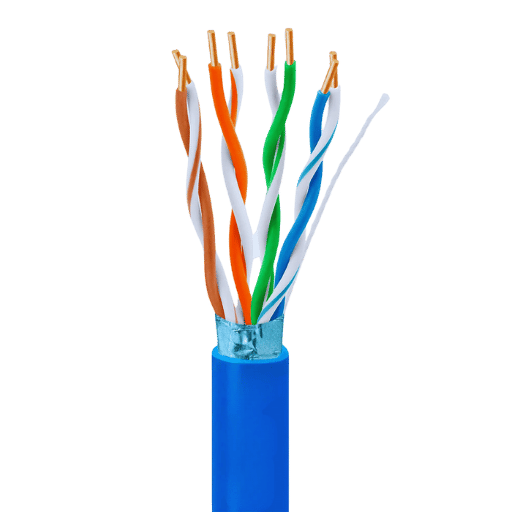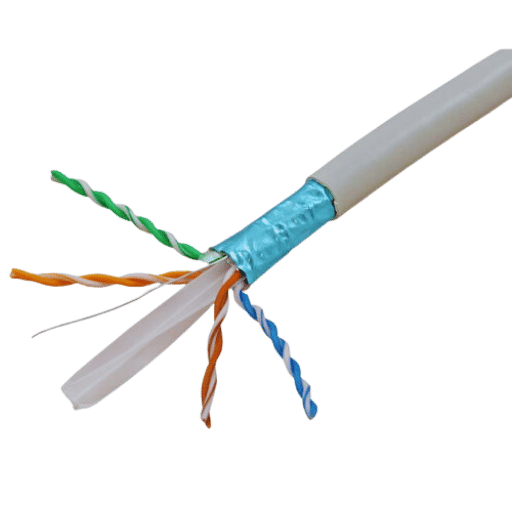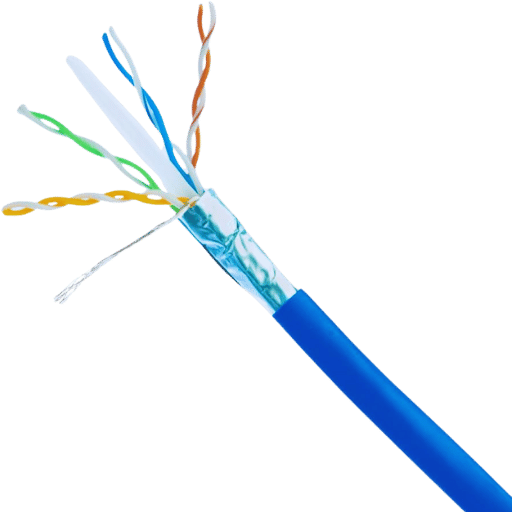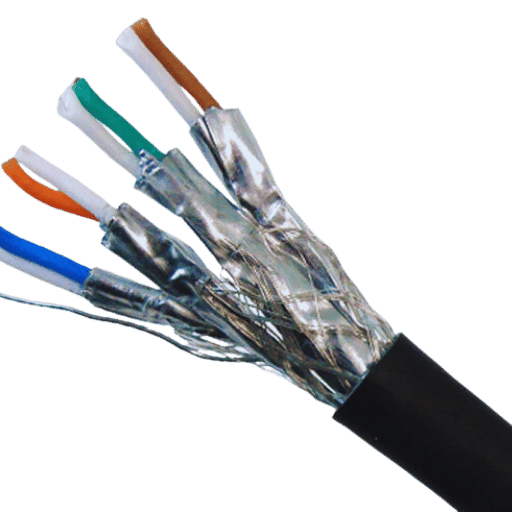In today’s world, where everything is driven by technology, there is nothing as important as a steady, fast internet connection. The requirement for efficient networking solutions grows with each device we connect. Shielded Ethernet cables are essential for establishing stable and secure network connections, particularly in places prone to electromagnetic interference (EMI). This article gives an all-inclusive description of shielded Ethernet cables; their types, advantages and applications. Any network installer, IT expert, or even someone who loves gadgets should know about shielded Ethernet cables because this knowledge will enable them to choose what best suits their needs to improve the performance and reliability of networks.
What Is a Shielded Ethernet Cable?

Understanding Shielded vs Unshielded Ethernet Cable
Shielded Ethernet cables, also known as STP (Shielded Twisted Pair), are made with extra shielding to protect the cable against electromagnetic interference (EMI) and radio frequency interference (RFI). This shield could be a combination of both braided metal or foil which wraps around the entire cable or twisted wire pairs. The main purpose of this shield is to prevent external interferences from corrupting or degrading data transmission.
On the other hand, Unshielded Ethernet cables, abbreviated as UTP (Unshielded Twisted Pair), do not have physical shields against EMI or RFI. Instead, these types of cables use “twisting” – a phenomenon that occurs because of the pairs of wires within them – to minimize interference. The more twists per inch in an unshielded ethernet cable, the better it can handle noise from outside but without any additional protection offered by shielded models.
More precisely:
Protection from Interference:
- Shielded Ethernet Cable (STP): Provides strong safeguarding from EMI/RFI thus most suited for high-noise environments like industrial areas, data centers etc.
- Unshielded Ethernet Cable (UTP): Provides weak protection against EMI and RFI therefore error rates may rise leading to poor performance where there is lots of signal pollution.
Installation and Handling:
- Shielded Ethernet Cable (STP): Typically thicker and less flexible due to added shielding, making it difficult to install, especially when space is a limiting factor. It must also be grounded for effective operation.
- Unshielded Ethernet Cable (UTP): Generally more flexible than its counterparts hence easy installation plus does not require grounding which allows for use in most general network setups.
Cost:
- Shielded Ethernet Cable (STP): Usually costlier because they need more materials during the manufacturing process as well as being complexly designed.
- Unshielded Ethernet Cable (UTP): Generally cheaper than its shielded counterpart since it lacks certain features which may be unnecessary for residential or commercial applications.
Performance:
- Shielded Ethernet Cable (STP): Can handle higher data rates over longer distances without being affected by external interference thus, recommended where there is a need for maximum signal quality.
- Unshielded Ethernet Cable (UTP): Works well with most common networking needs but not so good at dealing with high levels of noise hence might experience problems in such environments.
In conclusion, selecting between shielded and unshielded ethernet cables depends on the specific requirements of your network environment. Shielded ethernet cables should be used in places where there are many interferences that can affect data integrity and performance, while unshielded ones are cheap and easy to install in less demanding situations where flexibility during installation is considered important.
Types of Shielding in Ethernet Cables: Braided, Foil, and More
The reason behind using shields in Ethernet cables is to safeguard data transmission from electromagnetic interference (EMI) and crosstalk. Some of the shielding types commonly used in Ethernet cables are as follows:
- Braided Shielding: It consists of a mesh made of copper wires woven together, making it highly flexible and durable. This type can effectively deal with low-frequency interferences but usually takes up more space than others.
- Foil Shielding: It uses either copper or aluminum foil, which is very thin in nature. Being lighter weight compared to braided shielding, this type provides better protection against high-frequency interference. However, if these cables are bent repeatedly or flexed often, they may get damaged easily.
- Combination Shielding: To capitalize on each one’s strengths, some cables use both braided and foil shields simultaneously, thus creating combination shielding; such designs offer a strong defense against a wide range of frequencies that cause interference, hence being employed within environments having high levels of EMI.
Knowing about different types of shields will help you choose wisely when setting up your network installation. It will give you clear information on what may suit your needs best.
Benefits of Using Shielded Ethernet Cable
Employing shielded Ethernet cables has many advantages, particularly in areas where electromagnetic interference (EMI) and radio-frequency interference (RFI) are common. Here are some of the main benefits:
- Higher Data Integrity: Shielded cables reduce signal loss and crosstalk, leading to more reliable data transmission with fewer errors.
- Better Network Performance: Shielded cables protect against EMI and RFI, which helps maintain optimal network speed and performance—especially important for high-frequency, data-intensive applications.
- More Durable and Longer Lasting: Shielded cables – especially those with braided or combination shielding – offer stronger physical protection against damage over time.
- Compliance with Industrial Standards: Many shielded Ethernet cables meet strict industry standards or regulations so they can be used in sensitive environments like hospitals, factories, or data centers where failure might have catastrophic consequences.
To sum up this article; using shielded ethernet cable greatly increases the reliability of networks in places full of electromagnetism.
When Should You Use Shielded Ethernet Cable?

Identifying Environments Prone to Electromagnetic Interference (EMI)
Being able to recognize electrical and electronic machinery that emits strong electromagnetic fields is one way to identify places that are susceptible to electromagnetic interference (EMI). These could be factories with large equipment, hospitals with many different medical devices, or broadcast stations with lots of transmitting gear. Because of the number and strength of electronic tools in such environments, they frequently suffer from heavy EMI; therefore, shielded Ethernet cables should be employed there in order to uphold network integrity as well as performance.
Comparing Shielded Ethernet Cable with Unshielded Cable Options
Comparing shielded and unshielded Ethernet cables can be done by examining the installation environment, performance requirement, and cost. Below are some of the main differences and their relative figures:
Protection against Electromagnetic Interference (EMI):
- Shielded Ethernet Cables (STP/FTP): These cables have a metal shield that is used to minimize EMI most effectively, hence suitable for places with high electrical noise.
- Unshielded Ethernet Cables (UTP): These cables lack any form of shielding and thus can degrade performance in environments with EMI. However, they work well when there is little or no interference.
Quality of Data Transmission:
- Shielded Cables: Usually maintain signal integrity at higher frequencies and over longer distances. For instance, a Category 7 cable can support up to 600 MHz which leads to cleaner transmissions.
- Unshielded Cables: Though capable, UTP may suffer from more noise, especially at higher frequencies or over long distances. A category 6 cable supports up to 250 MHz, which may be unstable under heavy interference but is good enough otherwise.
Installation and Maintenance:
- Shielded Cables: Need careful grounding and more involved installations due to their intricate nature; improper grounding can lead to nullifying the benefits of shielding or even ground loops.
- Unshielded Cables: They take less time during setup because there is no need for grounding; they are also easier to handle since they are flexible with smaller sizes.
Cost Considerations:
- Shielded Cables: Generally expensive because additional materials are required, along with complex manufacturing processes. This also includes costs incurred during installation, which might call for specialized technicians.
- Unshielded Cables: Relatively cheaper than their counterparts, making them ideal where budgets are tight for low-EMI settings.
Application Scenarios:
- Shielded Cables: Best suited for industrial areas, data centers, healthcare facilities among others where electronic devices are densely populated leading to high EMI levels.
- Unshielded Cables: Can be used in offices, residential buildings, and other commercial establishments where EMI is not a significant concern.
Comparative figures show that while shielded cables provide better performance and protection against high levels of EMI, unshielded cables offer cost-effective reliability for standard applications. The decision ultimately depends on specific requirements as well as conditions within the network installation environment.
Real-World Applications: From Homes to Data Centers
When we analyze the real-world uses of shielded cables versus unshielded cables, it becomes apparent that each type addresses particular environmental requirements. Unshielded cables are chosen for use in residential houses over their counterparts because they are easier to install and more cost-effective. In an average home setting, there is hardly any electromagnetic interference (EMI), thus making these unshielded wires the most appropriate ones to select since they work well without compromising their performance.
On the other hand, data centers and industrial environments are where shielded cables come into play. High EMI levels require this protection in order to keep data integrity intact while operating within such areas. At data centers, shielded wires boast high-performance attributes that guarantee the smooth transmission of information with minimal interference from neighboring electronics; this also lowers noise caused by nearby electronic equipment’s vibrations during processing stages. On the same note, shielded cables are important in ensuring the reliability of communication between machines and devices that produce strong electromagnetic waves in industries.
Medical care facilities have a preference for using shielded wire connections so as not to put vital health-related records at risk, which might be tampered with due to the many electronic gadgets found in these places. This implies that different situations call for different kinds of wires depending on what they can inherently do when connected within particular operational contexts outside labs or theoretical explanations.
How to Choose the Right Shielded Ethernet Cable?

Comparison of Cat5e, Cat6, and Cat6a Shielded Ethernet Cables
Shielded Ethernet Cables Cat5e:
- Bandwidth: Up to 100 MHz.
- Maximum Speed: 1 Gbps.
- Maximum Distance: 100 meters.
- Use Case: Residential and small business applications with moderate data transmission requirements.
Shielded Ethernet Cables Cat6:
- Bandwidth: Up to 250 MHz.
- Maximum Speed: 10 Gbps over short distances (up to 55 meters).
- Maximum Distance: 100 meters at reduced performance (1 Gbps).
- Use Case: Professional environments such as offices where higher data rates are often needed.
Shielded Ethernet Cables Cat6a:
- Bandwidth: Up to 500 MHz.
- Maximum Speed: 10 Gbps.
- Maximum Distance: 100 meters.
- Use Case: Data centers, robust data transmission required for high-performance networks with minimal interference.
Key Factors: Bandwidth, Speed, and EMI Requirements
When picking a shielded Ethernet cable, there are three primary considerations: bandwidth, speed, and Electromagnetic Interference (EMI) requirements.
- Bandwidth: The ability to transfer data at higher rates is determined by wider bandwidth. For regular network use, 100 MHz is supported by Cat5e cables. Cat6 cables have up to 250 MHz which satisfies larger data requirements; whereas Cat6a cables can transmit up to 500 MHz making it suitable for demanding environments with heavy data transmission needs.
- Speed: A cable’s supportable maximum speed is crucial in ensuring an efficient flow of information. Residential and small business settings should not exceed 1 Gbps, which Cat5e cables can handle. Over short distances of up to 55 meters, Cat6 cables can manage speeds of up to 10 Gbps required in professional setups, whereas through the entire length of 100 meters, Cat6a cables maintain speeds at this range, hence perfect for high-performance networks found within data centers.
- EMI Requirements: Shielded wires help reduce EMI in electrically noisy areas where reliable communication may be hampered by electromagnetic interference (EMI). For most standard applications, basic shielding provided by category five twisted-pair copper network cable is enough. Still, improved shielding offered by category six or six should be used when there is considerable EMI, such as in an industrial setting or highly electronic office space.
Evaluate these criteria against your specific environment and data transmission needs so that you select the right shielded Ethernet cable for your situation.
Understanding Cable Types: UTP, FTP, and STP
To maximize the performance and reliability in different settings, one must know the dissimilarities of UTP, FTP, and STP when selecting Ethernet cables.
- Unshielded Twisted Pair (UTP): These cables are light, flexible, and easy to install because they do not have any extra shelters. They are cost-effective and can be used in places with low electromagnetic interference, such as home offices or regular commercial spaces. Most commonly used for general networking applications.
- Foiled Twisted Pair (FTP): Also known as F/UTP, these types of cables consist of an overall foil shield which protects against EMI by shielding all pairs together. FTP is more flexible than UTP while providing better protection against EMI that’s why it is often used where there is moderate electronic interference found in small to medium-sized enterprises (SMEs).
- Shielded Twisted Pair (STP): With individual shields for each pair along with an overall shield around them all, STP has very strong construction which provides excellent defense against both crosstalks as well as EMI. It is used for highly sensitive networks or those requiring high performances such as industrial sites, data centers etc., where lots of electronic interferences exist.
The choice between UTP, FTP or STP will depend on your network needs, installation environment and budget. If you have a low-interference area then UTP offers cheaper solution whereas if your place has moderate EMI then go for FTP type otherwise select STP cable to achieve maximum data integrity & transmission performance in high-interference locations.
How to Install Shielded Ethernet Cable?

Step-by-Step Guide to Installation
Prepare the environment.
- Make sure that the work area is neat and clear.
- Confirm that all required tools and materials are available, including cable cutters, a crimper, connectors, and shielded Ethernet cable.
Measure and Cut the Cable
- Determine the length of cable that will be needed based on your installation plan.
- Cut off the measured length using cable cutters to ensure a good, clean cut.
Strip the Cable
- Peel off about 2 inches of the outer jacket of both ends of the cable with a wire stripper.
- Gently strip away a partial inch from each inner twisted pair to expose the bare wire below.
Terminate with Connectors
- Arrange exposed wires according to T568A or T568B wiring standard.
- Put wires in an RJ45 connector, making sure they are properly aligned.
- Use a crimping tool to fasten the connector onto it tightly.
- Repeat this process at the other end as well for this purpose.
Test with a Cable Tester
- Check continuity and proper wiring with a cable tester.
- Ensure the connection of the shield correctly while checking whether this line works well or not.
Installing Cable
- Avoid sharp bends and pressure points by routing cables through designated pathways.
- Fix it down with suitable cables, ties, or clips whenever necessary.
- Connect ends to network devices or patch panels.
By following this manual you can correctly install shielded Ethernet cables so as to maximize network performance, preventing any EMI interference effects.
Common Installation Mistakes to Avoid
Incorrect Measurement of Cable Length
- If you do not measure the cable correctly, you can either have too much slack which may cause loss of signal or have a length that is not enough thereby subjecting the cable to additional stress.
Improper Cable Stripping
- Over-stripping the cable can damage inner conductors while under-stripping it may fail to leave enough exposed wire for termination. Be keen on stripping so that the integrity of the cable is maintained.
Wires Misalignment
- Failure to align wires properly with T568A or T568B standards can result in connection failures and other network-related problems. It is important to confirm alignment before crimping.
Bad Crimping
- When RJ45 connector is poorly crimped, there will be loose connections and intermittent faults. Use crimping tool consistently pressurizing it for tight connection.
Cable Not Tested
- If you skip testing cables, faults go undetected, which affects the performance of networks. Always ensure continuity and proper wiring using a cable tester.
Routing And Securing Inappropriately
- Sharp bending, too much pulling, and pressure points on the cable may lead to weak points in its strength, thus affecting performance. Ensure good routing and securing methods that will prevent these problems from happening.
These general mistakes should be avoided so that reliable, fast Ethernet installation can be achieved and, therefore, overall network performance improved.
Tools and Accessories You Will Need
In order to install shielded Ethernet cables effectively, you should have some tools and accessories. Some of them include:
Cable Tester
- This is used to ensure that the cable works well and the connection remains unbroken.
Crimping Tool
- It applies even pressure on RJ45 connectors so as to secure them at both ends of a cable.
Cable Stripper
- To strip off outer insulation from a cable without damaging the inner conductors, one needs this tool.
RJ45 Connectors
- These are points where Ethernet cables terminate; they can also be shielded for extra protection.
Punch Down Tool
- To securely connect wires to patch panels or wall jacks, you must use this particular tool.
Cable Management Accessories
- These comprise clips, organizers, and cable ties, which help keep wiring neat and tidy.
Boots for RJ45 Connectors
- Connector ends need shielding, so boots come in handy. Apart from providing protection against strain, they also do so against dust particles, thereby ensuring the longer lifespan of any given system connected through an ethernet connection.
All these tools are important if you want your installation to be professional-looking, efficient, reliable, and safe.
FAQ: Common Questions About Shielded Ethernet Cable

Can Shielded Ethernet Cable Improve My Network Speed?
Certainly, protected Ethernet cables do not quicken up the network connection by themselves but shield against electromagnetic interference (EMI) and crosstalk, hence improving signal integrity and steadiness. As a result of that, there will be steady performance, mostly when dealing with areas having too much interference.
What Is the Difference Between Cat6 and Cat6a Shielded Cables?
Both Cat6a shielded cables, and Cat6 shielded cables are built for high-speed network applications, but they have different performance levels and specifications. They can carry a maximum of 1Gbps over 100 meters or 10Gbps over 55 meters with a frequency of 250 MHz. On the other side, Cat6a cables can reach up to 10GBps over 100 meters at a higher frequency of 500 MHz. With better alien crosstalk prevention capability and more rigid performance requirements, which also help reduce electromagnetic interference (EMI), Cat6a is better suited for use in demanding networking environments than its counterpart – Cat Six Shielded Cable.
Why Is Grounding Important for Shielded Ethernet Cables?
To keep your network in good condition, it is important to ground shielded Ethernet cables. This will enable the shield to take away electromagnetic interference from the signal-carrying wires, thereby minimizing noise and crosstalk. If not grounded, the shielding can also interfere with the signals, leading to poor quality and slow performance of the whole network. Additionally, grounding guards against static electricity as well as electrical surges, which are likely to damage network equipment, hence making it more dependable and safe. For the best outcome, one side of a cable’s shielding should be grounded at least near a switch or panel used for networking purposes.
Reference Sources
Category 6 cable
Modular connector
Ethernet
Frequently Asked Questions (FAQs)
Q: What is a shielded Ethernet cable?
A: A network cable of this kind contains extra shields to fight electromagnetic interference (EMI) and crosstalk. Such wires are necessary in areas with high EMI levels because they guarantee reliable data transfer.
Q: What are the advantages of using a shielded network cable over an unshielded one?
A: Shielded network cables provide better protection against EMI thus signal integrity and performance is maintained even in harsh environments. They are most effective in places with many electrical noises or industrial settings.
Q: Can shielded Ethernet cables be used for outdoor applications?
A: Yes, outdoor cables or CMX labeled ones among the shielded Ethernet category protect against external elements while also providing defense from EMI.
Q: How does Cat6 shielded riser cables differ from Cat6a shielded riser cables?
A: While supporting up to 10GBPS speeds and 250MHZ frequencies, Cat6 shielded cables have lower capabilities than their counterparts, which support longer lengths of 100 meters at higher frequencies (550MHZ) – cat6a riser being more suitable for data-intensive applications.
Q: What is a shielded patch cable, and when should I use one?
A: In order to connect various devices like patch panels and Ethernet switches within an environment where there may be concerns about EMI, this short-length network wire has been fitted with some form of shielding that guards against such interferences.
Q: How does protection in Ethernet cables guard against electromagnetic interference?
A: To protect copper pairs from EMI, shielded Ethernet cables wrap them in a conductive foil or braided mesh. This stops your network from suffering signal degradation due to nearby electronic equipment or power lines interfering with it.
Q: What kinds of shielding do Ethernet cables have?
A: Foil Twisted Pair (FTP), Shielded Twisted Pair (STP), and double-shielded (both foil and braid) are among the different types of shielding available for Ethernet cables. Each one offers varying levels of EMI protection.
Q: What is meant by the 23AWG or 24AWG marking on Ethernet cables?
A: AWG is an abbreviation for American Wire Gauge, which specifies wire thickness inside a cable. Larger diameter 23AWG wires perform better than smaller diameter 24AWG ones but are less flexible. Typically, the fatter wire can sustain higher data rates over longer distances.
Q: Is there much difference between Cat6 shielded and Cat8 Ethernet cables in terms of performance?
A: Yes, there is a remarkable disparity. While Cat6 shielded supports speeds up to 10 Gbps and frequencies up to 250 MHz, Cat8 enables much higher rates at up to 40 Gbps with frequencies reaching as high as 2,000 MHz – making it perfect for ultra-fast data centers and enterprise networks.
Q: Can regular RJ45 connectors be used with shielded Ethernet cables?
A: Although using standard RJ45 connectors is possible, it’s preferable to go with shielded RJ45 connectors made specifically for this purpose. Such connectors maintain continuity of shielding throughout the entire cable length thus providing optimal EMI protection.
Post Views: 4,689




